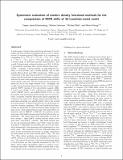Systematic evaluation of modern density functional methods for the computation of NMR shifts of 3d transition-metal nuclei
Date
30/12/2021Metadata
Show full item recordAbstract
A wide range of density functionals from all rungs of Jacob's ladder has been evaluated systematically for a set of experimental 3d transition-metal NMR shifts of 70 complexes encompassing 12 x 49Ti, 10 x 51V, 10 x 53Cr, 11 x 55Mn, 9 x 57Fe, 9 x 59Co, and 9 x 61Ni shift values, as well as a diverse range of electronic-structure characteristics. The overall 39 functionals evaluated include one LDA, 8 GGAs, 7 meta-GGAs (including their current-density-functional - CDFT - versions), 9 global hybrids, 4 range-separated hybrids, 8 local hybrids, and 2 double hybrids, and we also include Hartree-Fock and MP2 calculations. While recent evaluations of the same functionals for a very large coupled cluster-based benchmark of main-group shieldings and shifts achieved in some cases aggregate percentage mean absolute errors clearly below 2%, the best results for the present 3d nuclei set are in the range between 4-5%. Strikingly, the overall best-performing functionals are the recently implemented CDFT versions of two meta-GGAs, namely cM06-L (4.0%) and cVSXC (4.3%), followed by cLH14t-calPBE (4.9%), B3LYP (5.0%), and cLH07t-SVWN (5.1%), i.e. the previously best-performing global hybrid and two local hybrids. A number of further functionals achieve aggregate deviations in the range 5-6%. Range-separated hybrids offer no particular advantage over global hybrids. Due to the overall poor performance of Hartree-Fock theory for all systems except the titanium complexes, MP2 and double-hybrid functionals are unsuitable for these 3d-nucleus shifts and provide large errors. Global hybrid functionals with larger EXX admixtures, such as BHLYP or M06-2X, also perform poorly, and some other highly parameterized global hybrids also are unsuitable. For many functionals depending on local kinetic energy tau , their CDFT variants perform much better than their "non-CDFT" versions. This holds notably also for the abovementioned M06-L and VSXC, while the effect is small for τ-dependent local hybrids and can even be somewhat detrimental to the agreement with experiment for a few other cases. The separation between well-performing and more poorly performing functionals is mainly determined by their results for the most critical nuclei 55Mn, 57Fe, and 59Co. Here either moderate exact-exchange admixtures or CDFT versions of meta-GGAs are beneficial for the accuracy. The overall deviations of the better-performing global or local hybrids are then typically dominated by the 53Cr shifts, where triplet instabilities appear to disfavor exact exchange admixture. Further detailed analyses help to pinpoint specfic nuclei and specific types of complexes that are challenges for a given functional.
Citation
Schattenberg , C , Lehmann , M , Buehl , M & Kaupp , M 2021 , ' Systematic evaluation of modern density functional methods for the computation of NMR shifts of 3d transition-metal nuclei ' , Journal of Chemical Theory and Computation , vol. Articles ASAP . https://doi.org/10.1021/acs.jctc.1c00964
Publication
Journal of Chemical Theory and Computation
Status
Peer reviewed
ISSN
1549-9618Type
Journal article
Description
M.B. gratefully acknowledges support from EaStCHEM and the School of Chemistry in St Andrews.Collections
Items in the St Andrews Research Repository are protected by copyright, with all rights reserved, unless otherwise indicated.

